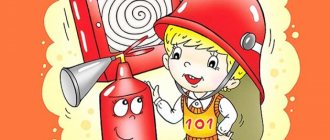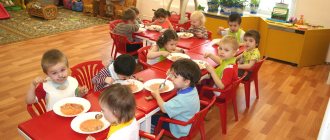My kindergarten
Author: Elena Anatolyevna Vladimirtseva, teacher, Municipal Autonomous Preschool Educational Institution “Kindergarten No. 227”, Russia, Perm.
Familiarizing children of senior preschool age with the professions of adults is one of the important tasks of a child’s socialization.
Abstract: Familiarizing children of senior preschool age with the professions of adults is one of the important tasks in raising a child. Currently, the world of professions is very wide and diverse. Along with well-known professions, new professions are also emerging. The reasons for the emergence of new professions are the high pace of modern life and the development of information technology. In this regard, there is a need to familiarize preschoolers with a variety of professions. The relevance of the formation in children of primary ideas about the work of adults, its role in society and the life of each person is justified by the Federal State Educational Standard for preschool education. Introducing preschoolers to the world of professions is an important stage in the process of professional development of the individual. It is at this time that active socialization of children occurs, ideas about the world of professions accumulate as a complex, dynamic, constantly developing system. If 10-15 years ago it was enough to introduce children to the work of a cook, salesman, driver, doctor, military man, then at the present stage this is not enough. Modern reality dictates new demands to us. Familiarizing children of senior preschool age with the professions of adults is one of the important tasks of a child’s socialization. The idea of professions allows children to penetrate deeper into the world of adults, understand and accept it. It creates interest in work, gives rise to a dream about one’s own future, and allows one to be proud of the results of the work of one’s close relatives and people in general. Experiencing the influence of the results of adults’ work on themselves, children practically internalize its significance.
However, in recent years, professions have emerged whose content is difficult for preschoolers to understand. As a result, children have insufficient knowledge and low vocabulary on this topic. It is very difficult for the younger generation to navigate the world of professions. It is difficult to choose a profession in your life. Very often, not only preschoolers, but also schoolchildren have very vague ideas about the world of adult professions. Even if the child visited his mother or father at work, he still did not understand the essence of their professional activity.
Currently, teachers face a difficult task. On the one hand, to interest children and introduce them to professions that will be in demand in the future, and on the other hand, to instill in children the desire to become professionals in their field. It is necessary to promote the socialization and adaptation of the younger generation in the world around them.
Based on the relevance of the topic, I set a goal and formulated tasks for work to familiarize children of senior preschool age with the professions of adults.
Goal: developing an understanding of the importance of any work, the need for interconnection and mutual assistance between people of different professions.
Tasks:
- Deepen and expand children’s knowledge about professions and the relationship between different types of work; give specific knowledge and ideas about the profession according to the scheme: name of the profession - place of work - working conditions - tools for work - labor operations performed - result of labor.
- Continue to introduce children to new modern professions of adults, equipment and tools, paying attention to the development of the scientific and technical sphere and safety precautions when performing various types of work.
- To form children’s ideas about the role of modern technology.
- Expand children's understanding of the work of adults and teach them to transfer acquired knowledge into their activities.
- Cultivate interest and respect for workers, a desire to work for others. Bring to the understanding that human activity is a necessary basis for his existence.
In order to qualitatively and successfully solve the assigned tasks, a developing subject-spatial environment was created in the group, which contributed to the development of the personality of preschoolers and their behavior, and also allowed me, as a teacher, to introduce pupils to the professions of adults through various forms of activity. I tried to create such conditions so that the process of becoming familiar with the work of adults would become an exciting activity for children. To organize work in groups, special centers were set up to introduce adults to work with game modules, role-playing games, and visual material. A properly organized developmental subject-spatial environment made it possible to: deepen the practical knowledge of students, identify their interests and inclinations, develop interest and the ability to carry out actions. When conducting educational activities with pupils, she used various means and forms of work, constantly changing types of activities, thereby increasing the cognitive activity of pupils. She formed in children an idea of the variety of professions, the structure of work (what and how a person does, why he does the work, what is obtained as a result of work). Introducing various forms of work with students, she used an individual approach, innovative educational methods and gaming technologies, which are the foundation of all preschool education.
When introducing preschoolers to the professions of adults, along with traditional forms of work, I used non-traditional ones.
I’ll tell you about one of them – this is a virtual tour. A virtual excursion is an organizational form of training that differs from a real excursion in the virtual display of real-life objects.
The advantages are accessibility, the possibility of repeated viewing, clarity, the presence of interactive tasks and much more.
During the virtual excursion, the illusion of a real trip is created. The child is immersed in the world of the unknown through the monitor screen. Having examined the conditions and tools of labor of a particular profession, the child uses his knowledge in independent activities and his role-playing game becomes more intense and productive.
Currently, the quantity and volume of material available via the Internet is constantly growing, and teachers have the opportunity to use these resources and create their own electronic excursions of their choice and thus not depend on external factors that impede the educational process.
Electronic excursions when working with older preschoolers allow you to obtain visual information about places that are inaccessible for real visits; they do not require large financial and time expenditures, as they are created using information technology.
Game is a historical activity of children, which consists in reproducing the actions of adults and the relationships between them. The most important rule for adults: it is not enough for a child to know about the profession, he needs to play it! Gaming technology is built as a holistic education. It includes sequentially:
- creative (role-playing, theatrical, constructive) game;
- didactic (game with an object, board - printed, verbal)
- moving (plot, non-plot);
- folk (individual, collective, household).
Game technologies are the foundation of all preschool education.
One of the main types of games is a role-playing game. It allows you to concretize and expand children’s ideas about the various activities of adults, their relationships with other people, professions, tools used, etc.
Preparation for games in a profession takes place wherever only a child can get acquainted with certain qualities of specialties, accumulate the necessary amount of information, even if minimal, but based on which, it is already possible to recreate in the game a distant semblance of this type of human activity.
Understanding the professional work of adults, the formation of the most basic ideas about professions, or rather even the rudiments of them, is possible only in the process of role-playing games, in which production plots, situations, and the professional social environment are imitated.
In older preschool age, play activities become more complicated. In an instant, a child can become a driver, a fireman, or a doctor.
In her work to familiarize children with the professions of adults, she used the pedagogical technology of organizing role-playing games. This technology is based on the principle of child activity, is characterized by a high level of motivation and is determined by the natural needs of a preschooler. This technology combines elements of play and learning. Unlike games in general, a pedagogical game has an essential feature:
- a clearly defined learning goal;
- a pedagogical result of cognitive orientation that corresponds to the goal.
In role-playing games, the child’s personality, his intellect, will, imagination and sociability are successfully developed, but most importantly, this activity generates a desire for self-realization and self-expression. In games on the theme “transport”, knowledge of traffic rules is improved, children learn to fulfill their plans and play in accordance with the role. In games, students try to imitate the professions of their parents.
Didactic games play an important role in introducing preschoolers to professions. Didactic play is a means of all-round development of a child. In my work I used didactic games, as they contribute to the assimilation and consolidation of knowledge and skills in students, and develop mental abilities. They form and deepen knowledge about people of different professions, develop speech, replenish and activate the vocabulary, form correct pronunciation, and develop coherent speech. For example, such didactic games - exercises “Who needs what for work? Who's doing what? Professions, What would happen if…”, etc. With great pleasure, my children became acquainted with the professions of adults through a theatrical game in which they played out plots from literary sources. Theatrical performances, where they were both actors and spectators, brought particular joy to the children. This form of work made it possible to engage shy, insecure students and reveal their potential. Likewise, the students interacted with dolls dressed as people of different professions. While playing with them, we analyzed and drew conclusions: why does a person of this or that profession need this type of clothing. For example: “Why does a builder need a helmet?”, “Why does a miner need a helmet with a flashlight?”, “Why does a cook need an apron and a cap?”, “Why does an astronaut need a spacesuit?” etc. The pupils received special attention from printed board games: “Who needs what?”, “What’s missing?”, “Inserts”, where the simplest task is to find two completely identical ones among different pictures. Gradually the task became more complicated - the child had to combine the pictures not only by external features, but also by content. In the games “What does a builder need?”, “What is in the store?”, “What does a journalist need?”, students selected pictures based on common features and established connections between objects. The main difficulty in introducing children to professions is that a significant part of the work of adults is not available for direct observation. Therefore, pupils were introduced to the work of adults and their professions through the organization of observations and excursions. Such forms of work ensured the greatest expressiveness of ideas, the maximum effectiveness of the knowledge acquired by students, where they discovered and consolidated the acquired knowledge in practice, and showed communicative qualities. During the observation process, the children’s attention was concentrated on those aspects of adults’ work that are of greatest importance for instilling in them the right attitude towards work. Observing the work of adults had a positive effect on the behavior of children and their attitude towards working people. Another undeniable plus is that work to familiarize children with the professions of adults in the form of observations and excursions contributed to interaction with the families of the students. It is no coincidence that the family plays an important role in the process of introducing preschoolers to the professions and work of adults. The informational influence of parents can manifest itself in all types of their educational activities, since at every step we are faced with the need to give the child information about a particular profession. These are, first of all, accessible conversations about yourself, your work, explanations of fairy tales, works of fiction, illustrations for them, cartoons, i.e. everything seen and heard. One of the forms of work was the weeks of parental professions, when parents of pupils - representatives of various professions - came to the kindergarten. Conversations with parents, looking at the tools they brought, photos and videos, and most importantly, live communication with mom or dad, aroused the genuine interest of the children. Together with parents, we designed photo exhibitions, video presentations, lapbooks, video clips, photo albums. Parents were involved in project activities. Parents helped organize excursions to their workplaces to help their children develop a clear understanding of their profession. One of the effective methods of modern education is the project method, which is based on the independent activities of students (research, cognitive, productive, during which the child learns about the world around him and transfers the acquired knowledge to real life.) The project method is also good because it is a special mechanism interaction between family and kindergarten. In my case, working on projects (“Builders”, “Journalists”) allowed students, using simple examples, to more deeply master the concepts of certain professions, increase independent activity, develop creative thinking, the ability to independently, using various forms and methods, find information about subjects and decide problematic situations created by the teacher. As part of the project activities, a model of three questions was used:
- What do your parents do and what do you know about their professions?
- What should we do to find out?
- How can we communicate what we learn?
Answering these questions, the children and I determined the stages of work on the project. The main stage of the project involved conducting final thematic classes: “I want to become an astronaut!, Who should I be?” Conversations: “Who works in kindergarten”, “The World of Professions”, “Objects and tools needed by people of different professions”, etc., didactic and outdoor games, familiarity with proverbs and sayings about work. I believe that the goals of the projects have been achieved and the tasks have been solved, since the students reflect their impressions in playful and productive activities. In the process of working on the topic being studied, the students took part in a variety of entertainment and leisure activities, where they gladly tried on the role of an actor, musician, singer, dancer, and athlete. A lot of time was devoted to children’s independent activities:
- productive types of children's activities (design of albums, professional-oriented CPC (production of attributes for games), drawing, appliqué, design, making collages and posters);
- performing labor actions (at the request or instructions of an adult).
In independent activities, children consolidated and expanded their acquired knowledge about professions. As a result of the work, the pupils began to actively show interest in the professions of their relatives, be proud of their parents, and try to evaluate the results of the work of adults. Children know the purpose of professional equipment, tools and materials in the work activities of adults. Professions are distinguished according to essential characteristics, and important qualities of representatives of different professions are named. They highlight the structure of labor processes, explain the role of labor in human well-being, model in a game the relationships between people of different professions, participate in feasible work activities of adults, have an emotionally positive attitude towards work and work in general, and demonstrate a conscious way of safe behavior in everyday life. These results guide me towards further continuation and development of activities in a given direction. I hope that as a result of such multifaceted work, my students will in the future choose a profession that will allow them to feel happy and in demand.
The term “profession” (Latin professio - officially specified occupation, specialty, from profiteer - I declare my business), the type of work activity (occupation) of a person who has a complex of special theoretical knowledge and practical skills acquired as a result of special training and work experience. Professional activity is usually the main source of income.
The history of the emergence of professions - in the era of primitive people, when there was no division of labor, there were no professions. As society developed, market relations arose between people and specialization by type of labor appeared. People became fishermen and hunters. Blacksmiths and potters, they exchanged the products of their labor. Knowledge and skills were passed on from generation to generation. A division of labor appeared. Professions appeared. Currently, the world of professions is very wide and diverse. A profession can combine several specialties. Doctor - surgeon, ophthalmologist, therapist, dentist, etc. Teacher - history, geography, mathematics, etc. Engineer - civil engineer, design engineer, safety engineer
There is a concept - position held. This is the range of responsibilities that a person performs regardless of his specialty. - director, head Department, Deputy Director, Assistant Teacher, Art. teacher
Professions have their own classification
| Job classes | "Man-man" | "Man-Technology" | "Man-sign system" | "Man-artistic image" | "Man-nature" |
| Types of professions | Related to medical care, consumer services, legal protection | Related to the creation of structures, installation, assembly and adjustment of technical devices, operation of technical equipment, repair of equipment | Related to text, numbers, formulas and tables, drawings, diagrams, sound signals | Related to the creation of works of art, design, modeling, and reproduction of products from sketches | Related to the study of living and inanimate nature, caring for animals and plants, and treating diseases of plants and animals |
The relevance of the work to familiarize children with the professions and work of adults is justified by the FGT to the structure of the educational educational program, which determine the content of psychological and pedagogical work on the development of educational fields. In accordance with the FGT, the content of the educational field “Labor” is aimed at achieving the goal of developing a positive attitude towards work through solving the following tasks:
development of labor activity;
fostering a value-based attitude towards one’s own work, the work of other people and its results;
the formation of primary ideas about the work of adults, its role in society and the life of each person.”
The formation of generalized ideas about the significance of the work of adults requires that children, first of all, have clear concepts that in each specific process a result is achieved that has a precise purpose - to satisfy a particular need.
Familiarization with the work activities of adults is crucial for the formation of a child’s initial ideas about the role of work and the importance of professions in the life of society.
Look for methodological developments on the specified topic and didactic material in the drop-down menu.
“Getting to know the world of professions” class hour
Class hour
Getting to know the world of professions"
Target:
- Expand students' knowledge about professions;
- Help in identifying your interests and abilities;
- Foster interest and a sense of responsibility in choosing a profession;
- Inform them about the qualities inherent in people of certain professions.
Class progress
Teacher:
Today we will talk about what a profession is.
(Slide 1).
Every morning you come to school to study - this is your main job, and your parents go to work. They perform different tasks and assignments, have different responsibilities, or, as they also say, have different professions. Let's see what work, for example, your mothers do? (Slides 2-6)
The world of professions is huge, there are more than 50 thousand of them, with about five hundred new ones appearing every year and the same number disappearing and changing. Is it easy to understand this diversity and make the right choice? Some professions flirtatiously change their names, pretending to be modern. You won’t immediately understand that the bartender is a bartender, and the manager is a manager.
Next year you are ninth graders. Not all of you will go to the tenth grade after finishing the ninth grade. Do you think you will be able to get a job? Why? (Answers from the guys).
Right. First you need to acquire a profession. A profession should be chosen to one’s liking, it should interest a person, then it will bring joy to the person, and the matter will progress.
II. So what is a profession? Can a person get a profession right away, without preparation?
That's right, first you need to study at a technical school, institute or other educational institutions. Let's first turn to the explanatory dictionary to find the answer to the question: What is a profession? (Slide 7).
The word “profession” comes from two Latin words: “professio” - officially designated occupation, specialty and “profitero” - I declare my business. This word, like many other terms, has multiple meanings.
A profession is a type of work activity that requires certain training and is usually a source of livelihood.
III.
Today we will not only get to know specific professions, but we will also try to find out and identify your inclinations for certain professions. But first, let's do a warm-up game in the form of a game.
Game “Guess the profession” (Slide
(What professions are we talking about?)
- Strike while the iron is hot. (Blacksmith).
- To eat a fish, you have to get into the water. (Fisherman).
- It is not the needle that sews, but the hands. (Tailor, seamstress).
- Without taking up an ax, you cannot cut down a hut. (A carpenter).
- He who is not lazy to plow will produce bread. (Plowman).
- Don't put the collar on the tail, don't start things from the end. (Groom).
Teacher:
While playing, we refreshed our memory and remembered many different professions and specialties. (Slide 9)
.To choose a profession, you need to find out what professions exist. This is the first step, our comrades will help us take it.
Speeches by students about professions.
Would you like to know what professions you are inclined towards?
There are many different professions and specialties, and “finding a job you like is quite difficult.
What should you consider when choosing a profession?
First
– this is
interest.
One is interested in traveling, another is interested in programming something on a computer, and another is interested in playing music on the piano. To ensure that a profession is not a burden, you need to choose it in the area of your interests. Interests may change.
Second
, what you need to pay attention to are
tendencies.
Tendencies depend on the development of the left and right hemispheres of the brain. One of you
- Technicians, some are humanities specialists, and others have the same attitude towards technical and humanities disciplines. To identify inclinations, you can answer the questions of a differential diagnostic questionnaire. (Slide 10)
This is what we will do now. I will read out examples of types of activities, and you will put “+” or “-“ signs opposite the numbers of these types of activities on the answer sheets.
- “+” like;
- I really like “++”;
- "-" do not like;
- “-—” I really don’t like it.
Questions on the questionnaire: (Slides-11-13)
| 1a. Take care of animals. | 16. Maintain machines, instruments, compile computer programs. |
| 2a. Help sick people. | 26. Create tables, diagrams, computer programs. |
| Behind. Monitor the quality of book illustrations and posters. | 36. Monitor the condition and development of plants. |
| 4a. Process materials (wood, fabric, metal). | 46. Advertise, sell goods. |
| 5a. Discuss popular science articles. | 56. Condemn plays and concerts. |
| 6a. Raise animals. | 6b. Help your friends in work and sports. |
| 7a. Tuning musical instruments. | 76. Drive a tractor, diesel locomotive, etc. |
| 8a. Give people information (at the information desk, on excursions) | 86. Design exhibitions, participate in the preparation of concerts. |
| 9a. Repair things, products. | 96. Look for and correct errors in texts and drawings. |
| 10a. To treat animals. | 106. Perform calculations, calculations. |
| 11a. Breed new varieties of plants. | 116. Design cars, design houses. |
| 12a. To sort out disputes between people, to convince, to explain | 126. Understand drawings and diagrams. |
| 13a. Observe the work of amateur artists. | 136. Study the life of microbes. |
| 14a. Set up medical devices. | 146. Provide medical care to people. |
| 15a. Write reports on observed phenomena. | 156. Describe events artistically. |
| 16a. Do laboratory tests in the hospital. | 166. Examine patients and prescribe treatment. |
| 17a. Paint walls, decorate products. | 176. Install buildings, assemble cars. |
| 18a. Organize cultural trips and excursions | 186. Participate in concerts and performances. |
| 19a. Make parts, build buildings. | 196. Draw, copy cards |
| 20a. Fight plant diseases. | 206. Work on a typewriter. |
Processing the results.
Now we need to count the number of pluses and minuses in each column of the table.
Select the column that has the most pros and the fewest cons. The largest amount of advantages will indicate your preferred group of interests, and perhaps your inclinations towards certain areas of professional activity. Each of the 5 columns corresponds to a specific type of profession . (Students calculate the result themselves).
| P | T | H | ZS | XO |
| 1a | 1b | 2a | 2b | 3a |
| 3b | 4a | 4b | 5a | 5 B |
| 6a | 7b | 6b | 9b | 7a |
| 10a | 9a | 8a | 10b | 8b |
| 11a | 11b | 12a | 12b | 13a |
| 13b | 14a | 14b | 15a | 15b |
| 16a | 17b | 16b | 19b | 17a |
| 20a | 19a | 18a | 20b | 18b |
Let's summarize the testing results.
— What type of professions do you belong to according to your interests? (Slide 14).
“Man is nature" –
all professions related to crop production, livestock farming and forestry
(agronomists, livestock breeders, dog breeders, zoo workers, forest nurseries, etc.)
“ Man - technology” -
all technical professions
(builders, machinists, pilots, drivers of all types of transport, textile and chemical woodworking workers).
Man – “Sign system”
– professions related to calculations, digital and alphabetic signs
(programmers, computer operators, postmen, librarians, linguists, economists, etc.)
Man – “Artistic image”
These are
architects, artists, singers, musicians, composers, fashion designers, designers, theater, film, circus artists, makeup artists, and stylists.
So, you were able to determine what type of profession you are inclined towards. But in addition to interest and inclinations, you also need to have abilities
to the profession. Abilities are individual psychological characteristics of a person that help achieve success in any activity. Having chosen a profession, you need to read about it, ask adults, or better yet representatives of this profession, what abilities are needed for work, and then compare your abilities with those necessary for the chosen profession. The necessary abilities can be developed.
It is also possible to identify unsuitability
to the chosen profession. For example, deviations in health that are incompatible with a given profession (a person who is allergic to pollen should hardly become a florist), characteristics of temperament (a melancholic person should not choose a profession when he needs to quickly navigate changing conditions; a phlegmatic person is unlikely to work successfully there where instant response is required).
IV. Game “The Most” (Slide 15)
Try to answer questions with elements of humor.
Name your profession:
- The sweetest (pastry chef, salesperson in the confectionery department);
- The most monetary (banker, model,...);
- The hairiest (hairdresser, ....);
- The funniest (clown, parodist, comedian);
- The greenest (gardener, forester, florist...);
- The most children's (educator, pediatrician, teacher...);
- The most serious (sapper, surgeon, psychologist...).
Requirements that professions place on a person.
When a young person chooses a profession, he is interested in his profession being popular with employers not only today, but also in 10-20 years. This is called stability of demand for a profession. Along with the “eternal” professions - builder, doctor, teacher, etc., the transport, chemical industry, high technology, communications, new professions at the intersection of traditional ones, economic management, and the social sphere are becoming relevant. At the same time, for professional success at the present stage of development of society, personal qualities, skills, hard work of a person, and readiness to continuously improve their professionalism become more important. An indicator of the stability of demand for a profession is the number of jobs in a particular specialty available at different enterprises in the district and region. Achieving a goal depends on a person’s desire, determination and will.
The main factors or conditions for choosing a profession are aspects of a well-founded professional plan, which takes into account the interests, abilities, state of health, abilities of the person choosing a profession and the needs of society for personnel.
Conventionally, these components of the profession formula can be designated as “want”, “can”, “need”. Briefly, the formula for a “good choice” can be expressed in three words (Slide 16).
| A good choice | ||
| necessary | Want | Can |
(Conversation with students):
— How do you understand the formula “good choice”?
(Students' answers).
Conclusion from the class teacher:
"Want"
–
(interests and inclinations).
Interest is the desire to understand an object or phenomenon, the desire to study it. Inclinations are the desire to engage in a particular activity. Interests and inclinations may or may not coincide with each other; they may be directed towards one, several, or many types of activities.
"Can"
–
(human capabilities, abilities, health status).
Abilities are individual abilities of a person that ensure the success of performing any activity, the ease of assimilation and mastery of this activity, and the creative capabilities of a person.
"Necessary"
–
(society’s needs for personnel).
Society needs specialists of various professions. When choosing a profession, you need to coordinate your choice with the need of social production for personnel. The combination of these three important factors when thinking about a professional plan will help determine the optimal ways to choose a profession for each person, which is extremely important for the current labor market conditions.
General structure of vocational education (Slide 17).
A profession can be obtained in various types of educational institutions, depending on what level of professional education you choose:
Vocational education can be primary, secondary and higher.
Primary vocational education –
represented by lyceums, vocational schools, which provide a working specialty.
Secondary vocational education
allows you to become a mid-level specialist in most executive or creative professions. Secondary vocational education can be obtained by having basic general, secondary (complete) general or primary vocational education.
At the same time, if a person already has secondary (complete) general or primary vocational education, then he can receive secondary vocational education through shortened accelerated programs.
Higher professional education
represented by state and non-state universities. When choosing a non-state educational institution, it is necessary to check the licenses, accreditations and certifications of the educational institution. Without the specified 3 documents, a diploma from an educational institution does not provide national guarantees of employment.
Where can you get information about professional educational institutions
(Slide 18).
Information about educational institutions providing vocational training can be obtained:
- In reference books for applicants to educational institutions;
- In telephone directories;
- In computer information retrieval programs on the INTERNET;
- In advertisements;
- In libraries;
- In OPK;
- In regional employment centers;
- In conversations with representatives of educational institutions and teachers;
- When meeting with students and alumni;
- During personal visits to educational institutions.
Typical mistakes in choosing a profession (Slide 19).
Summary of the class hour:
I want to end today's class hour with this poem:
Fate prepares thousands of paths, stores hundreds of mysteries in store. What it will be like is your path. You have to predict it. Will you drive ships, Or learn the secrets of centuries, Will you build a bridge from the Moon to the Earth, Maybe you will forge iron. You will grow up to be a clown - the funniest one - and the world will bloom with smiles. The world also needs clowns - They send our souls flying. Choose which path for yourself - You won’t know until the door opens. Try to walk the path as a human being. Believe in your strength, believe in victory.
Self-analysis of the class hour “We and the world of professions”
Classroom goals:
- Expand students' knowledge about professions;
- Help in identifying your interests and abilities;
- Foster interest and a sense of responsibility in choosing a profession;
- Inform them about the qualities inherent in people of certain professions.
The class hour is structurally consistent.
1. Start of the class hour:
introduction to the topic, articulation of the goal.
2. Educational activities:
began with an unusual form: viewing slides of a “tour” to the places of work of the students’ parents.
Clarification of the concept of “profession” as a type of work activity that requires certain training and is usually a source of livelihood.
There was also a game moment during which it was determined whether the students could use a proverb to determine the profession that a person is engaged in. Most professions were identified by the students, with the exception of the groom profession.
The students also prepared information that they shared with their classmates, telling them about the professions of a software engineer, correspondent, fashion designer, and pilot.
The teacher said that to choose a profession, you need to take into account three components: interest, inclination, and ability of a person.
Next, diagnostic work was carried out, which consisted of: 1) an explanation of how to answer the questions of the differential diagnostic questionnaire; 2).how to process your results and find out your preferred group of interests.
Based on the test results, it was determined that out of 14 students present at the class hour:
- 4 (29%) have inclinations towards the “man-nature” type - all professions related to crop production, livestock farming and forestry (agronomists, livestock breeders, dog breeders, zoo workers, tree nurseries, etc.);
- 4 (29%) – to the “person-to-person” type - all professions related to serving people, communication (teachers, doctors, salespeople, tour guides, lawyers, police officers, hairdressers, etc.);
- 4(29%) – “human-technical” – all technical professions (builders, machinists, pilots, drivers of all types of transport, workers in the textile, chemical woodworking professions, shoemakers, etc.);
- 1 (6.5%) – to the “person-sign system” type – professions related to calculations, digital and alphabetic signs (programmers, computer operators, postmen, librarians, linguists, economists, cashiers, etc.);
- 1(6.5%) – person – artistic image.” These are architects, artists, singers, musicians, composers, fashion designers, designers, theater, film, circus artists, makeup artists, and stylists.
During the discussion of the test results, students’ attention was drawn to the fact that the necessary abilities when choosing a profession must be constantly developed. However, it happens that a person may be unsuitable for the chosen profession (for example, due to health, temperament).
The “most-most” game helped to consolidate students’ knowledge of professions and specialties, during which students gave their examples with elements of humor. For example, the greenest one is a gardener, forester, etc. At the end of the class hour, students were familiarized with the main factors and conditions for choosing a profession: “I want”, “I need”, “I can”.
The class hour was the first of the planned events on this topic.
3. Summing up:
The class material and proposed forms of work
(games, conversation)
are selected taking into account the psychophysical development of students of this age and the recommendations of methodologists and psychologists.
During the class hour, the methodological principle of communication was observed.
I believe that the goal of the class hour has been achieved, because... students were able to understand what is needed to choose a future profession. All students worked, expressed their opinions, ideas, dreams.
From all this we can draw the following conclusion: carry out further work (in 11th grade)
on career guidance for students, expand knowledge about professions, recommend special
literature






